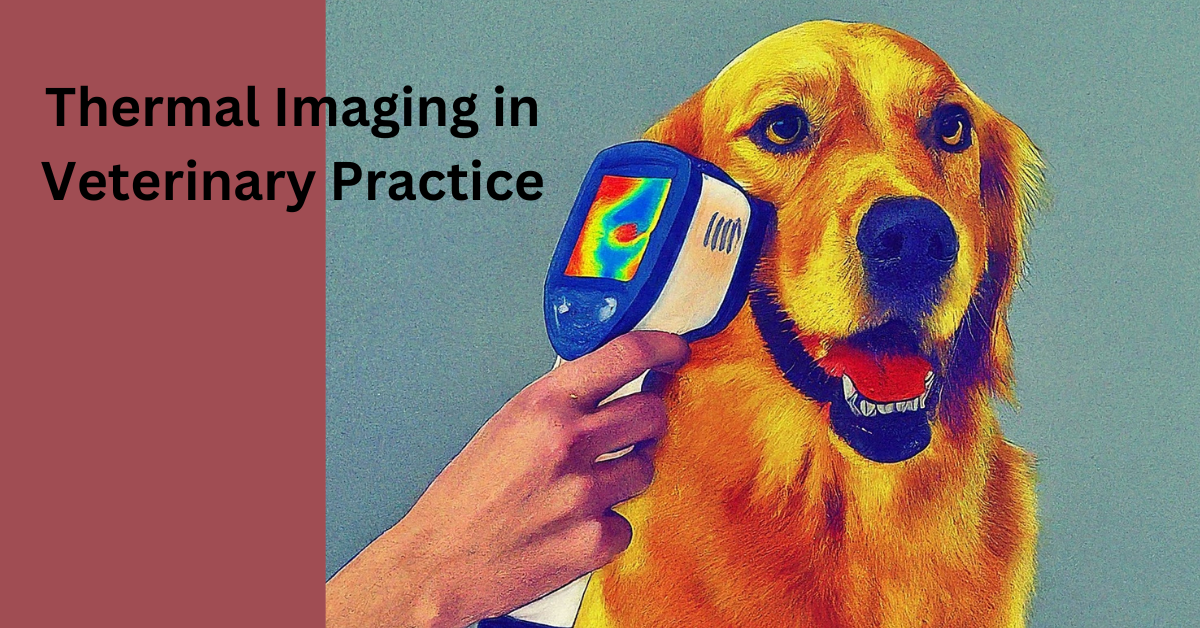Harness the Power of Thermal Imaging in Veterinary Practice
Thermal imaging is a versatile diagnostic tool that has a valuable role in diagnosing lesions early, before clinical signs are shown, as well as monitoring the response to treatment. All areas of veterinary practice, including livestock, equine, and small animals, can benefit from having access to thermal imaging equipment.
What is thermal imaging?
All organisms emit infrared radiation, which thermal imaging cameras detect and convert into a visual image or thermograph1,2,3. Infrared radiation is part of the electromagnetic spectrum that is not visible to humans, but infrared cameras can measure this energy and record each measurement as a specific color, producing a thermograph that can be used to diagnose lesions.
Each infrared measurement represents the skin temperature in a specific location, which changes depending on the underlying capillary blood flow.
Skin temperature may increase in an area in response to pain or inflammation, or it may decrease due to restricted blood flow.
The treating veterinarian can then use thermographs to identify asymmetrical areas or hotspots that represent altered blood flow and the presence of a lesion.
How can thermal imaging benefit veterinary practice?
Thermal imaging offers veterinary clinics and hospitals a versatile diagnostic tool that is unique to other diagnostic modalities.
It is a safe, non-invasive test that does not require any animal contact and minimal handling, so is especially useful for monitoring large numbers of animals, while also eliminating the need for chemical sedation for nervous or aggressive animals.
Current uses of thermal imaging in veterinary clinics
Determining the location of a lesion – A thermograph can rapidly and accurately identify the location of a lesion.
This information can then be used to decide on further diagnostic tests, saving valuable time and preventing unnecessary tests from being performed.
Monitoring response to treatment – Thermographs can be repeated regularly to monitor how well a lesion is healing and its response to treatment.
This can be useful for preventing re-injury and ensuring treatment is producing a satisfactory result6.
Preventing injuries in athletes – Thermal imaging can detect lesions before any clinical signs or lameness occurs. This can help avoid serious injuries by enabling treatment to be started early before the injury develops further.
Detecting health problems early – Thermal imaging can be used as part of a general health check or elderly pet examination to detect any lesions early before clinical signs are shown.
Painful conditions such as osteoarthritis are commonly diagnosed on thermographs, enabling treatment to be started at an earlier stage of the disease.
Detecting individuals in a flock or herd that is at risk of becoming unwell – In large groups of animals, thermal imaging can quickly detect any individuals with an increased skin temperature, allowing affected animals to be isolated from the herd and promptly checked before illness develops.
Uses for thermal imaging in equine veterinary clinics
In equine practice, thermography is a useful diagnostic tool for diagnosing lameness such as acute laminitis, navicular disease, synovitis, fractures, back problems, and tendonitis.
It is widely used alongside lameness examinations and other diagnostic tests to help efficiently diagnose difficult-to-locate lesions.
How thermal imaging can be used in farm practices
Thermal imaging has a wide range of uses in farm practice as it can quickly identify unwell individuals within a large group.
Foot lesions in cattle can be detected using thermographs by identifying increases in hoof temperature, while early mastitis cases can be diagnosed by monitoring udder temperature.
Research also supports the use of thermal imaging for identifying infectious diseases such as Bluetongue, bovine respiratory disease, bovine viral diarrhea virus, and even exotic conditions such as foot and mouth disease.
In the future, thermal imaging may have a vital role in diagnosing infectious diseases.
Uses for thermal imaging in small animal veterinary hospitals
Thermal imaging can be used to identify lesions involved in spinal disease, joint disease, osteoarthritis, and cruciate disease in pets.
It has an important role in locating lesions and therefore guiding the use of MRI, and it can identify painful lesions early so treatment can be started promptly.
Thermal imaging can be used to assess wound healing, by detecting ischemia and non-viable tissue as a result of decreased capillary blood flow. It can also be used to monitor the success of skin grafts.
Research also supports using thermographs to locate malignant tumors in dogs and cats, by identifying an increase in regional skin temperature.
In the future thermal imaging may have a vital role in diagnosing benign and malignant tumours.
Thermal imaging already has a wide range of veterinary uses, making it a safe investment that will significantly benefit patient health and welfare.
Research also promises new and exciting upcoming uses for thermal imaging, guaranteeing that every veterinary practice will benefit from this exciting diagnostic tool.
References
Mota-Rojas D, Martínez-Burnes J, Casas-Alvarado A, Gómez-Prado J, Hernández-Ávalos I, Domínguez-Oliva A, Lezama-García K, Jacome-Romero J, Rodríguez-González D, Pereira AM. Clinical usefulness of infrared thermography to detect sick animals: Frequent and current cases. CABI Reviews. 2022;17(40).
Racewicz P, Sobek J, Majewski M, Różańska-Zawieja J. The use of thermal imaging measurements in dairy cow herds. Animal Science and Genetics. 2018;14(1):55-69.
Sung J, Loughin C, Marino D, Leyva F, Dewey C, Umbaugh S, Lesser M. Medical infrared thermal imaging of canine appendicular bone neoplasia. BMC veterinary research. 2019(1):1-7.
Rekant SI, Lyons MA, Pacheco JM, Arzt J, Rodriguez LL. Veterinary applications of infrared thermography. American journal of veterinary research. 2016;77(1):98-107.
Casas-Alvarado A, Martínez-Burnes J, Mora-Medina P, Hernández-Avalos I, Domínguez-Oliva A, Lezama-García K, Gómez-Prado J, Mota-Rojas D. Thermal and circulatory changes in diverse body regions in dogs and cats evaluated by infrared thermography. Animals. 2022 Mar 20;12(6):789.
da Silva TC, de Albuquerque Mariz TM, Escodro PB. Use of thermography in clinical and sports evaluations of equine animals: a review. Research, Society and Development. 2022;11(8).



